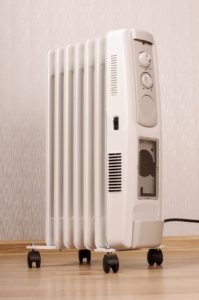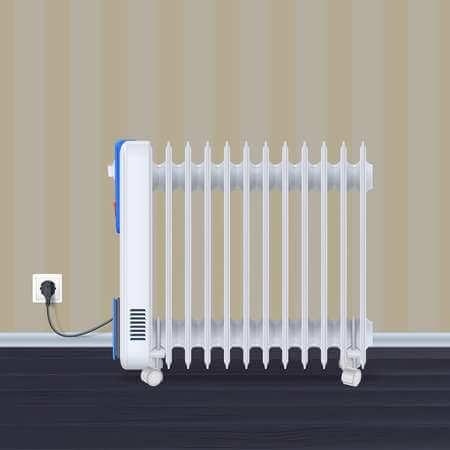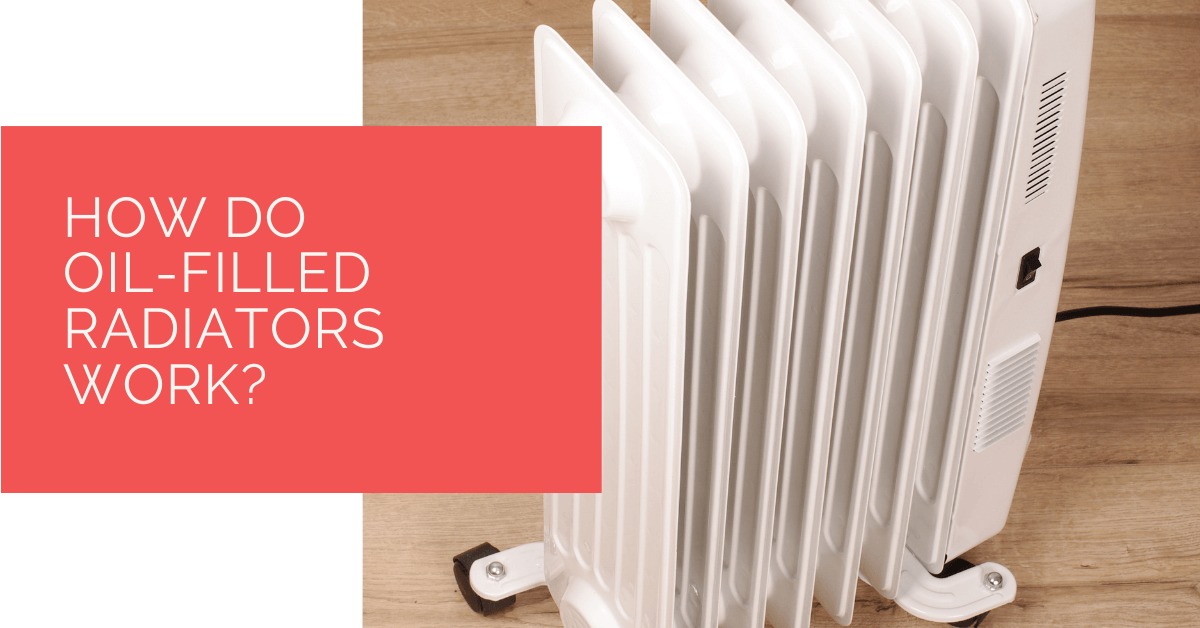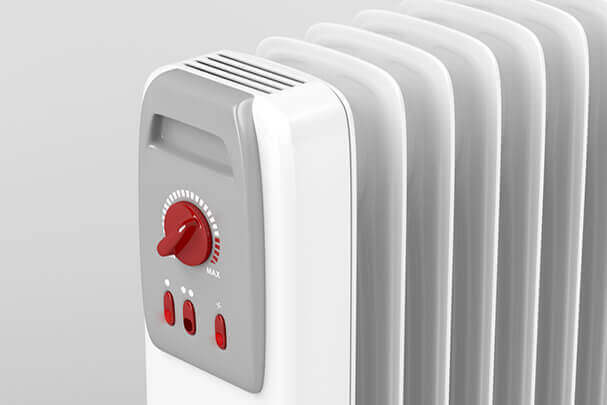The inner workings of our household appliances are a fascinating enigma that we seldom investigate since, after all, they perform the job. It’s not like you need an electrical schematic to operate your toaster.
The most curious among us, on the other hand, appreciate studying every last detail of our items, so if you’re one of them, this blog is for you.
Electric oil-filled radiators are among the most energy-efficient heaters available, but how do they function?
For some, they may seem self-explanatory, but you’d be shocked at how many misunderstandings still exist about this type of heating equipment. That’s why we’re getting up and personal with oil-filled radiators to learn more about how they work.
Contents
- 1 Key Takeaways
- 2 What Are Oil Heaters?
- 3 How Do Oil-Filled Heaters Work?
- 4 What Are the Advantages of an Oil-Filled Heater?
- 5 Oil-Filled Heater Troubleshooting
- 6 Where To Place Your Oil Heater?
- 7 Other Considerations To Be Made While Placing Your Oil Heater
- 8 Do Oil-Filled Heaters Use A Lot Of Power?
- 9 Heat Pump Source: Reliable Heating and Cooling Solutions
- 10 Conclusion
Key Takeaways
- Oil-filled radiators heat a reservoir of thermal oil with an electrical element, transmitting heat to the surrounding liquid. They employ convection to circulate warm oil, which heats the room.
- Advantages of oil-filled heaters include energy efficiency, silent operation, slow cooling, thermostat control, portability, and safety features like preventing overheating and no need for oil refills.
- Placement of oil heaters is crucial; they work best near the centre of a room and should not be placed too close to entrances or in open areas. Proper sizing and usage alongside central heating systems can optimize their efficiency.
What Are Oil Heaters?
Oil-filled heaters resemble traditional radiators in appearance, although they are much smaller. They are made up of a series of fins or columns connected.
They may have open spaces between the columns or fins attached to a base and have a control panel in front. Flat panels are seen on sure oil heaters, but they are uncommon.
Oil-filled heaters, unlike typical radiators, are portable. The link to the household electrical system via a conventional wall socket, allowing them to be relocated to any area that needs additional warmth. Many even include carrying handles, while larger ones typically have wheels to reposition easily.
How Do Oil-Filled Heaters Work?
The Basics
Oil-filled radiators function by heating a reservoir of thermal oil within the device with an electrical element. The electrical component is wholly immersed in the oil, so as it warms up, all of the heat is transmitted to the liquid around it.
Oil-filled radiators are similar to central heating devices in that both employ a heated liquid to convey warmth across the appliance’s surface. The main difference is that an oil-filled radiator utilises its internal heating element to warm the liquid within.
On the other hand, a boiler warms the water externally in the case of a central heating radiator and relies on a network of pipes.
On the other hand, an oil-filled electric radiator is a flexible, freestanding machine that can be mounted just about anywhere. In contrast, a central heating radiator is essentially an empty shell until hot water passes through it.

What is the Function of the Heating Element?
An oil-filled radiator’s heating element is just a coil of resistive metal wire put into the base. When an electrical current is provided, the electrons fight for space as they flow through the thin wire, causing friction and heat.
Warmth is delivered to the radiator body as the wire heats the oil, which then heats the air volume in the room. The heating element’s form and size may vary depending on the manufacturer, but the underlying concept remains the same.
Convection Inside, Convection Outside
You have seen a high-level overview of the healing process, but what happens within the heater to make our living rooms so warm and inviting? It all has to do with convection, a type of heat transmission that occurs when atoms in gases and liquids migrate from one place to another.
The molecules begin to flow in a convection cycle when the oil within the radiator heats up. Warm oil expands and rises to the top of the radiator, forcing any cooler oil down towards the element to be warmed. The liquid convection cycle inside the heater explains why certain parts of the radiator’s surface are colder than others.
Heat is transmitted to the radiator body as the warm oil circulates in this continuous cycle. Another convection process begins outside the heater.
Oil-filled radiators, like other radiators, give out two-thirds of their heat by convection, and many include fluted bodies or fins to maximise air contact. It is why smaller, portable oil-filled radiators have a similar form.
Although their fins are covered beneath a smooth, modern-looking exterior to combine efficiency and aesthetics, more oversized oil-filled radiators use the same principle, except their fins are not visible at first glance.
What Are the Advantages of an Oil-Filled Heater?
Now that you have a better understanding of how an oil heater works, you may be wondering why you should pick one for your house. There are several benefits, including:
- No Air: They don’t have a fan, which means they’re almost silent, and the air won’t dry out.
- Energy efficiency: An oil heater converts 100% of the energy it consumes into heat. It means you’ll save money on your utility costs, mainly because oil heaters don’t require extra electricity to run a fan.
- Slow cooling: Oil heaters are even more energy-efficient since they emit heat after turning off the electricity.
- Thermostat-controlled: Rather than constantly running after the room has achieved the desired temperature, the heater will cycle on and off to maintain the desired temperature. This will keep your room at a pleasant temperature while saving you money.
- No need to replenish oil: Oil will never need to be filled since it will never be utilised as energy source.
- Portable and lightweight: They may be transferred from room to room owing to their compact and lightweight design.
- Safety: While the metal surface will warm up, it will never become so hot that it will burn you. They may also be used safely indoors because no fumes or gas are created. Most models also include built-in safety mechanisms that turn off the heater in the case of a malfunction for your safety.

Oil-Filled Heater Troubleshooting
Oil-filled space heaters don’t require much in the way of upkeep or service. Electrical issues, such as defective wiring or a malfunctioning power switch, are the most prevalent.
They may be rectified by an authorized service professional. If your heater isn’t working and it isn’t the circuit’s fault, get it checked out by an expert.
An oil-filled heater might develop a leak at any time. If you observe a viscous liquid pouring from your device, turn it off and stop using it immediately.
Leaks cannot be rectified or supplied since the oil is locked within the heater at the manufacturing. Contact the manufacturer for replacement alternatives if your heater is still under warranty.
Where To Place Your Oil Heater?
The optimal location is near the centre since this allows heat to travel freely and evenly throughout the area. Heat is better contained in rooms with doors than in open areas, although heat is often lost when doors are opened and closed frequently.
In a house with an open floor plan, you may need more than one radiator in various locations to generate enough heat to make a significant impact. If the radiator is just being used to heat one room, it should not be positioned close to the entrance.
Even when the door is closed, heat escapes before it has a chance to circulate, especially if the room on the other side of the door is cooler.
Other Considerations To Be Made While Placing Your Oil Heater
Oil-filled radiators can warm an entire room, but they shouldn’t be used in place of a central heating system in the dead of winter. Choose the appropriate heater size for the area where it will be used. A too-small unit works twice as hard as a bigger one in a vast environment.
Instead of distributing radiators around the house, concentrate them in places where you spend the most time. Setting the thermostat on a furnace or other forced-air heat system around 20 degrees relieves part of the burden on the central system, and one or more radiators fill up the gaps only in the areas where they are needed.

Do Oil-Filled Heaters Use A Lot Of Power?
Most electric space heaters, including oil-filled heaters, use a resistive element to create heat. They are potentially more cost-effective than exposed-element heaters. The heat generated is transferred to the oil rather than being wasted due to radiation throughout the room. The oil, of course, radiates heat as well, but at a slower pace.
When the heating element is turned on, it consumes the same electricity as a resistive heater. However, this isn’t always the case due to the heat sink provided by the oil. Consequently, under typical conditions, an oil heater consumes less power in the long term than an exposed-element heater.
Heat Pump Source: Reliable Heating and Cooling Solutions
At Heat Pump Source, we take pride in our unwavering commitment to serving the UK with top-tier HVAC solutions. From the efficiency of heat pumps and the cool relief of air conditioning to the warmth of boilers, radiators, and underfloor heating, our dedicated team is always at the forefront of innovation. We understand the unique needs of every household and business, and we strive to provide dependable health and cooling products and services that are tailored just for you. Ensuring your comfort and satisfaction is our utmost priority. Whether you have questions, need guidance, or require support, we’re always here to assist. Please don’t hesitate to contact us; we’re eager to be of service.
Conclusion
Understanding how oil-filled radiators work reveals their remarkable efficiency and versatility as heating appliances. These heaters use a simple yet effective mechanism of heating thermal oil, harnessing convection to distribute warmth throughout a room. With numerous advantages, including energy efficiency, quiet operation, and safety features, oil-filled heaters are a practical choice for supplemental heating. Moreover, proper placement and sizing considerations further enhance their effectiveness. By comprehending their inner workings and optimizing their usage, we can make the most of these devices to keep our spaces warm and comfortable while conserving energy and maintaining safety.
About the Author
At Heat Pump Source, our articles are the product of a collaborative effort among a team of highly skilled HVAC experts. Our dedicated professionals, hailing from diverse backgrounds in heating, ventilation, air conditioning, and refrigeration, contribute their extensive knowledge and experience to every piece of content. This multidisciplinary approach ensures comprehensive coverage. Our commitment is to deliver authoritative, reliable, and tailored advice to meet the unique needs of every household and business across the UK.


